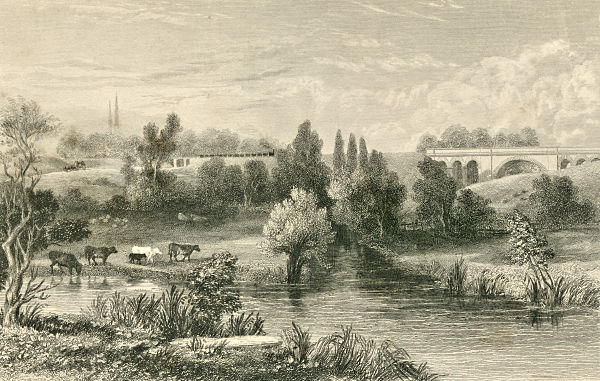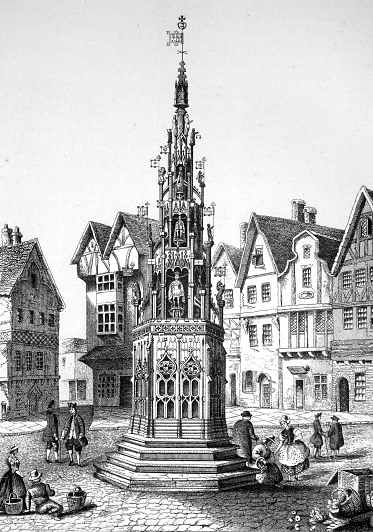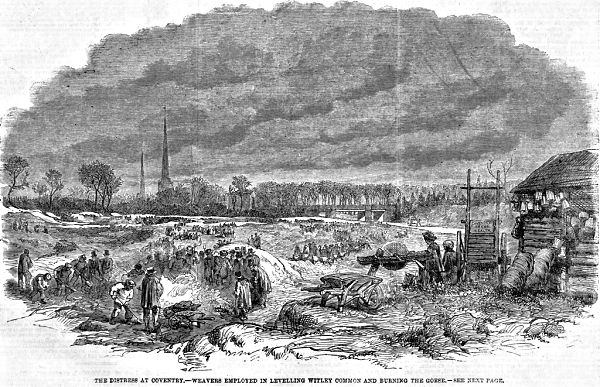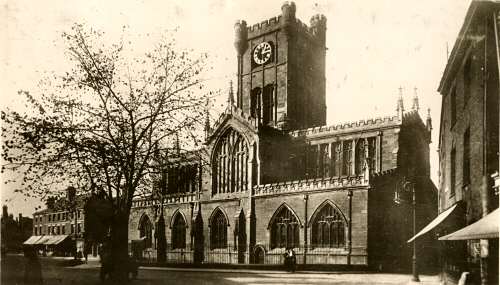|
Index...
|

 he first known settlement in the Coventry area was the Roman Fort Lunt at Baginton, although there was at the time a prior settlement at Corley. The first chronicled mention of "Coventry" was in 1016 when a 300 year old Nunnery founded by St. Osburga was destroyed by Canute and the invading Danes. Subsequently in 1043 Leofric and Godiva founded and endowed a Benedictine monastery in Coventry on the site. Leofric and Godiva were generous benefactors to religious houses across the Country but whilst Leofric is said to be buried in the City there is argument about the final resting place of Godiva. And whether Godiva rode naked to protest against taxation imposed upon the merchants of the city remains open to debate, but the story does suggest a vibrant trading settlement prior to the Norman invasion. In the Domesday Book Coventry had a population of around 350. As a local noblewoman Godiva would have met William of Normandy. She is one of the few Anglo-Saxons to retain her lands after the invasion, but although she is mentioned in the Domesday Book, she had died by the time of the great survey in 1086.
he first known settlement in the Coventry area was the Roman Fort Lunt at Baginton, although there was at the time a prior settlement at Corley. The first chronicled mention of "Coventry" was in 1016 when a 300 year old Nunnery founded by St. Osburga was destroyed by Canute and the invading Danes. Subsequently in 1043 Leofric and Godiva founded and endowed a Benedictine monastery in Coventry on the site. Leofric and Godiva were generous benefactors to religious houses across the Country but whilst Leofric is said to be buried in the City there is argument about the final resting place of Godiva. And whether Godiva rode naked to protest against taxation imposed upon the merchants of the city remains open to debate, but the story does suggest a vibrant trading settlement prior to the Norman invasion. In the Domesday Book Coventry had a population of around 350. As a local noblewoman Godiva would have met William of Normandy. She is one of the few Anglo-Saxons to retain her lands after the invasion, but although she is mentioned in the Domesday Book, she had died by the time of the great survey in 1086.
The River Sherbourne runs through the area covered by the early town providing a source of power for mills, and there were plentiful supplies of timber and stone available nearby. Being centred in the middle of the country and close to Watling Street and the Fosse Way also proved an advantage for trade and communications.

The City had two distinct halves and two churches were built around this time, Holy Trinity for the Prior's half of the City, and St. Michael's for the Earl's half. A motte & bailey castle was built in the late 11th Century. This was raised to the ground then rebuilt by 1140 only to be severely damaged by Henry II in 1273 - Broadgate is assumed to identify the location of the main gates and St. Mary's Guildhall was built partly on the site. The Castle largely then fell into ruin. One of the last mentions is in 1569 when Elizabeth I asked the people of Coventry to hold Mary Queen of Scots in the Castle, but such was the poor state of repair that Mary was held first at The Bull Inn in Smithford Street and then at the Guildhall before being moved to Chatsworth House in Derbyshire. From 1335 a City wall had begun to be built around the City but it was not completed for over 200 years in 1534 - by then it was a huge structure 2.2 miles round, 8ft thick and 12ft high containing 32 towers including 12 Gatehouses. In 1642 in the Civil War the Royalists were refused entry to Coventry and being unable or unwilling to break through they let the city be. On the restitution of the monarchy Charles II in 1662 ordered the City walls to be broken. The only two remaining Gates today are at Swanswell and Cook St.
Franciscan Friars (Greyfriars) arrived in the city in the 1270s and Carmelite friars (Whitefriars) 100 years later. Coventry was awarded its Charter of Incorporation by Edward III in 1345 not on the basis of being an important marketplace, but on the basis of "ancient prescriptive usage", ancient beyond memory or record (the first Statute of Westminster in 1275 had defined this as being limited to the beginning of the reign of Richard I in 1189). By 1372, with almost 5000 inhabitants, Coventry was the 4th largest City in England behind only London, York and Bristol and level perhaps with Norwich. Between 1404 and 1459 the Parliament of England sat occasionally in the City making it arguably the Capital of England. In 1451, and for the next 400 years, Coventry became a County in its own right - the County of the City of Coventry.

From 1300 a Cross is mentioned standing at the southern end of Cross Cheaping, where it meets Broadgate, probably a tall red sandstone plinth with a simple cross at the top. The site was the market place and also the place of executions. In 1423 the Court-Leet ordered a new Cross be made standing on 8 pillars. This lasted 100 years before it became unsafe and part of the upper section was taken down in 1537. A new Cross was ordered and completed in 1544. Brightly painted and gilded with gold the new Cross was 57ft high in 4 stories with statues on the top three levels - an assortment of kings on the third and the second levels, with saints on the top level, all topped with representations of liberty and justice at the highest point. In 1608 the City repaired it, replacing a figure of Jesus with Lady Godiva. In the 1750s the top two tiers were removed because it was unsafe and in 1771 the Council ordered its destruction. 200 years later a new Cross was unveiled in 1976, 100m from its original position, but the Council were redesigning the city centre and finally removed it again in 2019. It has not yet been re-sited.
Initially the prosperity of Coventry was concentrated in the Dyers who produced Coventry Blue cloth, famed for its non-fading qualities. By the 14th Century, with large sheep farms at Coombe and at the nearby Cistercian Abbey at Stoneleigh, Coventry had become an important centre of the cloth trade, mainly involving the weaving and dyeing of wool. However, despite the growing influence of the Council in the governance of the City, the Leet (the Guilds) increasingly legislated in matters relating to trades in the City and this hampered its growth. Close control was maintained over both existing trades and new ones - certain organisations were approved of while others were discouraged. The Tallow Chandlers Company was formed in 1515 and given a monopoly, and in 1520 butchers, bakers and fishmongers were named as being trades where one of their two Masters was chosen by the Mayor. Fortunes of each trade varied significantly over as the City developed as Leet regulations controlled everything from where material could be bought, to who could be involved in the manufacture, to which markets they could attend to sell. Brewing was also regulated according to circumstance, as were leather-workers, brickmakers and carpenters. Apprentices served their time and became Freemen of the City, and it was only Freemen who could vote for an MP or take a seat on the Council. The numbers of Freemen were strictly controlled by restricting the number of apprentices and the wages that could be paid. By 1523 the City was already being described as poor and decayed and 565 houses were standing empty in the 10 Wards. In 1538 Henry VIII ordered the closure of the Friaries in Coventry and in 1539 the Priory was closed. A visitation of the plague in 1604 further added to the City's distress. By the time of the Civil War the Freemen of Coventry relied not on their trades but on the keeping of cattle on the commons and by 1662 the city ranked 19th largest in England based on the number of hearths taxed. The Cloth trade continued to decline, suffering from over-regulation and competition from Gloucester and the West-Country. Coventry Clothiers lost at least £2000 worth of cloth lying in warehouses in London in the great fire in 1666 and many unemployed dyers and fullers were attracted to seek work further afield. Some left these shores for others across the seas as England began the export of undyed and undressed cloth to far-flung lands setting up in competition abroad.
But while the Cloth industry in Coventry declined, the manufacture of new cloths, and the new trade of silk-weaving began to provide alternative employment. James I (1603-25) had been the first to envy the Italians their silk trade and increasingly French Huguenots fleeing persecution in their own country were arriving in England bring with them, amongst other knowledge, experience with silk. However, when James ordered the growing and production of silk on a commercial scale, he had not taken into account that silk worms will only breed on white mulberry trees which will not flourish in England. And then the Civil War interrupted progress. It was not until 1718 when John and Thomas Lombe of Derby conducted a daring episode of industrial espionage in Italy and patented their specialist throwing frame that English factories were able to produce high quality silk. Beforehand the best European silk had been produced in Sardinia and the Italians imposed the death penalty on those who stole industrial secrets. John Lombe went to Italy as a tourist, and bribed his way into employment as a silk-winder. He sketched the machines and processes in secret and smuggled the drawings out in bales of silk bound for England. He was discovered but escaped and a new mill in Derby started the Silk industry in England. John died 6 years later aged 29, possibly killed by an assassin sent from Italy, but the secret was out, and the trade flourished.
Silk Weavers had formed their own separate company in Coventry as early as 1627 but by the mid-1700s and for the next hundred years silk became the dominant industry in the City. The thread that arrived in England had already been spun into skeins, tightly twisted and packed into sacks ready for the next stage - the throwing or throwsting. It is this stage only that was carried out in Throwsting Mills situated by sources of water power in villages such as Blockley, over 30 miles away in the Cotswolds. It was into Coventry that the spun skeins arrived to be delivered to the Throwsting Mills by ox-cart. The throwsting process consisted of winding threads from the skeins on to spindles suitable for the weaving looms back in Coventry.

 y 1800 60% of the population of Coventry was estimated to be employed in the silk trade. The centre of the city was by this stage a tangle of narrow cobbled streets lined with timbered houses. Leading off these streets were alleys, courts and yards packed with cramped brick cottages where weavers laboured in small workshops and top-shops where weaving workshops occupied the upper floors of residential properties. By 1828 Ribbon Manufacturers were setting up homes in the new Hillfields area between the City and Foleshill, the first suburb development outside of the City walls, leaving the centre to be dominated by weavers in their cramped conditions. Ribbon Manufacturers were the Great Masters of the trade. They paid an Undertaker - a middleman - to oversee the process of throwsting, weaving and dyeing the silk. The Manufacturer would pay the Undertaker who would pay two-thirds of this to the Weaver. In the slump in trade following the Napoleonic Wars Undertaking was phased out as margins tightened and many Undertakers went bankrupt. The Weavers remaining in the City parishes lived in crowded - often rented - accommodation and were generally poor. Many could not afford their own looms and were forced to rent, employing family members as free labour. The old timbered houses, often let to several families, were crumbling and even the brick cottages in the courts and yards were dark and poorly ventilated. There were few fires because silk had to be kept at the right humidity, free from dirt and smoke. As yet there was no sewage disposal or refuse collection. Children born into these conditions suffered a high death rate, and life expectancy was low. A Weaver generally had two looms, one for himself and one for his wife. At 6 or 7 years old children were set to quill the silk, at 9 or 10 to pick it, and at 12 or 13 were put to the loom to weave. A Weaver may have had 4 or more looms on which his family worked. The new Jacquard loom was expensive but offered twice the earnings of a plain silk loom. For those who could not scrape a living there was Parish Relief and the Workhouse, a feared stigma for a Weaver in such straits who would lose his Freeman and voting rights.
y 1800 60% of the population of Coventry was estimated to be employed in the silk trade. The centre of the city was by this stage a tangle of narrow cobbled streets lined with timbered houses. Leading off these streets were alleys, courts and yards packed with cramped brick cottages where weavers laboured in small workshops and top-shops where weaving workshops occupied the upper floors of residential properties. By 1828 Ribbon Manufacturers were setting up homes in the new Hillfields area between the City and Foleshill, the first suburb development outside of the City walls, leaving the centre to be dominated by weavers in their cramped conditions. Ribbon Manufacturers were the Great Masters of the trade. They paid an Undertaker - a middleman - to oversee the process of throwsting, weaving and dyeing the silk. The Manufacturer would pay the Undertaker who would pay two-thirds of this to the Weaver. In the slump in trade following the Napoleonic Wars Undertaking was phased out as margins tightened and many Undertakers went bankrupt. The Weavers remaining in the City parishes lived in crowded - often rented - accommodation and were generally poor. Many could not afford their own looms and were forced to rent, employing family members as free labour. The old timbered houses, often let to several families, were crumbling and even the brick cottages in the courts and yards were dark and poorly ventilated. There were few fires because silk had to be kept at the right humidity, free from dirt and smoke. As yet there was no sewage disposal or refuse collection. Children born into these conditions suffered a high death rate, and life expectancy was low. A Weaver generally had two looms, one for himself and one for his wife. At 6 or 7 years old children were set to quill the silk, at 9 or 10 to pick it, and at 12 or 13 were put to the loom to weave. A Weaver may have had 4 or more looms on which his family worked. The new Jacquard loom was expensive but offered twice the earnings of a plain silk loom. For those who could not scrape a living there was Parish Relief and the Workhouse, a feared stigma for a Weaver in such straits who would lose his Freeman and voting rights.
The Golden age of prosperity of the silk trade in Coventry lasted from 1813 to 1825 but already its downfall could be forecast. The problem for Coventry was that it had established itself as a city of small industrial establishments and independent craftsmen who were prepared to battle against modern methods of industrial production. Some Luddism occurred. The market supported their existence through government policy that prohibited the import of competition in the form of French ribbon, and whilst this continued there was no incentive to change. Weavers in Derby successfully introduced large scale steam looms but the four steam-loom factories that opened in Coventry in the 1830s failed. By 1830 Coventry had 13,000 looms employing 30,000 people largely working their own looms in their own house, mainly employing their own families. In 1826 came the beginning of the end. The prohibition on imports of French ribbon was replaced with a 25% tariff. The invention of the higher volume Dutch Engine Loom and then the Jacquard Loom - beyond the reach of individual weavers - opened the way for a factory system that Coventry weavers refused to contemplate until it was too late for most of them.

Within 30 years the trade in Coventry was nearly extinct. The Cobden Treaty of 1860 removed even the 15% tariff on imported ribbons. By 1865 fifty manufacturers in Coventry were bankrupt and weavers were leaving Coventry for Leicester, or Birmingham, or for the USA and Canada. William Horsfall arrived in Coventry and married Suzannah Avery in St. Michael's Coventry in 1737. William had probably come from Yorkshire with knowledge of the Woollen Cloth trade. He took on an Apprentice Weaver, Caleb Copson, in 1767. Of their 8 children 3 are known to have survived - John (born around 1740), William (born around 1749) and Lambert (born around 1755). Lambert, while still only a minor (aged 20) married Elizabeth Mullis at Holy Trinity church in 1775 with the permission of his father, witnessed by his brother John. There have been no children identified to the union but after Elizabeth died in 1790 it was probably this Lambert who took on an apprentice weaver William Smith in 1799. Lambert died in 1824.
In the meantime, John (b.1740) married Hannah Symonds in February 1762. The marriage is recorded both under St. John's church Coventry and under the Independent Church in Vicar's Lane for Dissenting Protestants. Of their 4 daughters and 5 sons and there is little to suggest that they did not initially continue in the silk trade although it seems that increasingly they and their children sought employment in other trades or elsewhere. Three sons Thomas, John and Richard all continued recording the baptisms of their children in the Dissenting Chapel. The only one to reach the 1851 Census, Thomas, is therein described as a Ribbon Manufacturer although still living in Bishop Street near the centre of the City that heads up towards the by-then 80-year-old Bishop Street Canal Basin.

William (b.1749) led a more complicated life. His first marriage in St. John's Church was to Mary Haddon by Licence, witnessed by his brother John and with the permission of his father in 1769 because he was not yet 21. But Mary died in February 1771 presumably in childbirth. His second marriage was in July to Nancy Cox, this time witnessed by both his brothers John and Lambert. With Nancy he had 5 children but only three survived beyond their teens and after their mother died none joined the silk trade. It seems likely that Nancy died in childbirth around 1782 because in October 1783 William married his third wife, this time in Holy Trinity Church - Ann Pearmain, witnessed by Lambert. The children that survived this marriage however did remain in the trade - Ann married a Ribbon Weaver and moved to Nuneaton, Joseph also was a Ribbon Weaver in 1841 living in Spon St, Lambert was in 1841 a Ribbon Weaver out in Radford but 10 years later he and his family were in Tower Street just to the North of the city centre.
But the story of William and Anne's first son John is more tragic. John, also a Ribbon Weaver, married Esther Keene from another weaving family in 1806, and although the marriage is recorded under St. Michael's they were Particular Baptists under the Cow Lane Chapel, off Jordan Well. The records of 8 children are religiously recorded in the records of that church between 1807 and 1826 and 6 are known to have survived. The 9th child Joseph however was born in 1829 and his mother Esther died in Childbirth. Joseph was never recorded at the Cow Lane Chapel. Four years later in 1833 his heartbroken Father also died making orphans of 6 children under the age of 17. The daughters were put into service and eventually married while the 1841 census shows Charles as an apprentice cordwainer, and Stephen as an Apprentice Weaver. Someone took Joseph to be baptised under St. Michael's Church in June 1837 and showed him as living in Much Park Street but he does not appear in the 1841 census. By 1851 he is living with his sister Mary's family, Weavers, in the Bull & Anchor yard, but he is a Whitesmith. The following year he marries Jane Hulk, daughter of a Hand Loom Ribbon Weaver living in Gosford St. 10 years later he is living in Little South St, still as a Whitesmith and wife Jane as a Ribbon Weaver and they have three children. By the mid-1870s the whole family has moved to the Dudley Road in Birmingham where Joseph becomes a Brass Bell Forger and while sons Thomas and Joseph become a Blacksmiths and metal forgers, daughter Emily marries into the burgeoning Birmingham brass industry.
Website by Rob Orland © 2002 to 2025